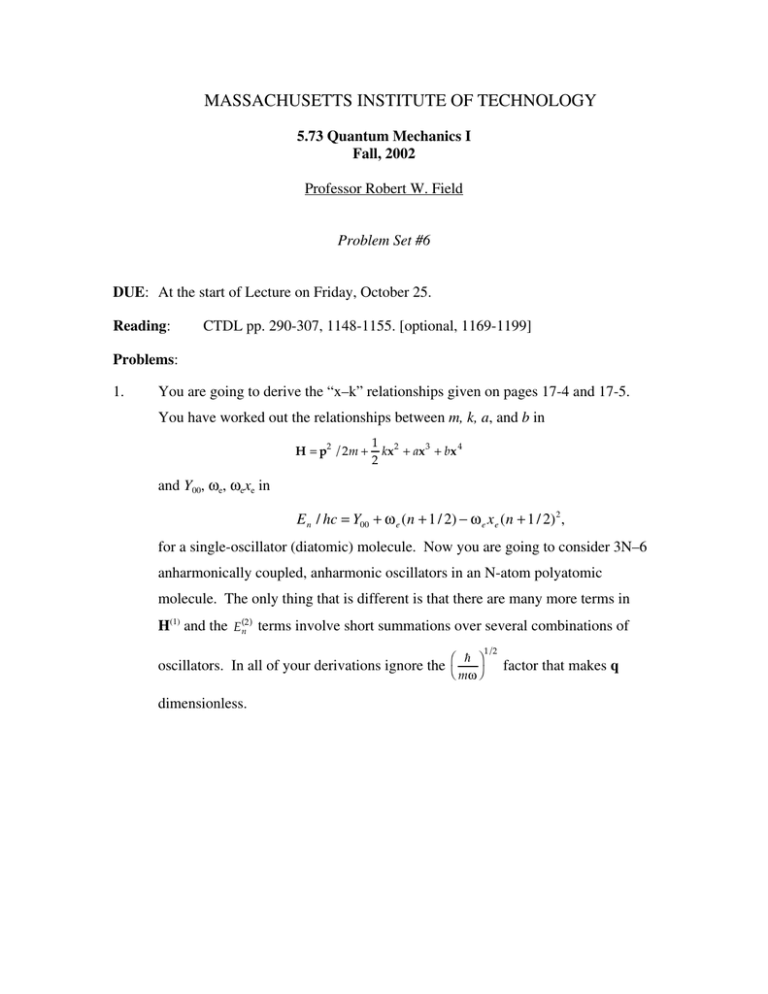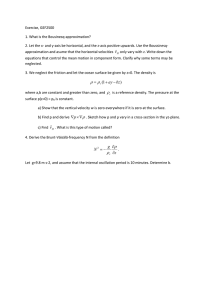MASSACHUSETTS INSTITUTE OF TECHNOLOGY
advertisement

MASSACHUSETTS INSTITUTE OF TECHNOLOGY 5.73 Quantum Mechanics I Fall, 2002 Professor Robert W. Field Problem Set #6 DUE: At the start of Lecture on Friday, October 25. Reading: CTDL pp. 290-307, 1148-1155. [optional, 1169-1199] Problems: 1. You are going to derive the “x–k” relationships given on pages 17-4 and 17-5. You have worked out the relationships between m, k, a, and b in H = p2 /2m + 1 2 kx + ax 3 + bx 4 2 and Y00, ωe, ωexe in E n / hc = Y00 + ω e ( n + 1 / 2) − ω e x e ( n + 1 / 2) 2 , for a single-oscillator (diatomic) molecule. Now you are going to consider 3N–6 anharmonically coupled, anharmonic oscillators in an N-atom polyatomic molecule. The only thing that is different is that there are many more terms in H(1) and the E (n2) terms involve short summations over several combinations of h oscillators. In all of your derivations ignore the mω dimensionless. 1/2 factor that makes q Chemistry 5.73 Problem Set #6 A. Page 2 xii appears in the energy level expression as E n 1 n 2 …n 3N −6 = L xii ( ni + 1 /2) 2 . The first term in the equation for xii on page 17-4 comes from one of the two strictly diagonal matrix elements of H(1). These are the ∆ni = 0 matrix elements of qi4 . Derive this term. B. The second term in xii comes from matrix elements of terms like qi q 2s . There are several classes of such matrix elements: (∆ni, ∆ns) = (1,0), (–1,0), (1,2), (1,–2), (–1,2), and (–1,–2). The first two have only ± ωi in the denominator, while the other four have energy denominators of the form ±ωi ± 2ωs. Sum these terms and derive the second term in the xii equation. C. The first term in xij on page 17-5 comes from another strictly diagonal matrix element of H(1) ( E n 1 n 2 …n 3N −6 = L xij ( ni + 1 /2) n j + 1 /2 ) which comes from diagonal (∆ni = 0, ∆nj = 0) matrix elements of qi2 q 2j . Derive this contribution to xij. 2. D. The second term in xij on page 17-5 comes from ∆ni = 0, ∆nj = 0 matrix elements of terms like qi2 qt and q 2j qt . The selection rules for qt is ∆nt = ±1 and the energy denominator will be ±ωt. Derive this term. E. [OPTIONAL] The final term in xij comes from matrix elements of terms like qiqjqt. There are eight such terms: (∆ni, ∆nj, ∆nt) = (1,1,1), (–1,1,1), … (–1,–1,–1) with corresponding energy denominators. Derive this term. In addition to the x-k relationships by which the vibrational anharmonicity constants, xij, are related to the cubic and quartic anharmonicity constants of the potential surface, perturbation theory can be used to derive the relationships of the rotational anharmonicity constants, α [iA, B, or C ] to the coefficients of the q 3i cubic anharmonicity term in the potential, e.g. 3 N −6 B v 1 , v 2 ,…v 3N −6 = Be − ∑ i =1 α i ( v i + 1 /2). For a polyatomic molecule, you need to know the partial derivatives of the reciprocal moments of inertia with respect to each of the normal coordinate displacements, and that information comes from a normal coordinate analysis (F Chemistry 5.73 Problem Set #6 Page 3 and G matrices) that is beyond the scope of this class. Here, you will solve the simpler problem of Bv = Be - αe(v + 1/2) for a diatomic molecule. The rotational “constant” operator is proportional to R–2, x = R − Re 2 x x R −2 = R e−2 1 − 2 + 3 + … Re Re 2 x x B v = Be 1 − 2 + 3 + …. Re Re So, by writing H as H(0) + H(1) H (0) hc = Be = 1( ≤ 1 1/2 aa + a ≤a) k µ) + Be J ( J + 1) ( 2 2 πc h 8 π2 cµR e2 H (1) / hc = (a hc )x 3 − 2 Be (x R e )J ( J + 1) and the second-order corrections to EvJ will contain three terms E (vJ2) a 2 = hc hc − ∑ (E v′ vJ x 3 v′ J (0 ) vJ ) − E (v0′)J hc + 4 B2e R 2e J (J + 1) 2 2 ∑ (E v′ v x v′ (0 ) vJ 2 ) − E (v0′)J hc v x v′ v ′ x 3 v ∑ (E 2aBe J (J + 1) hcR e 2 v′ (0 ) vJ ) − E (v0′)J hc where the first term is a contribution to ωexe, the second term gives the centrifugal distortion (De ≈ 4 B 3e ω 2e ) , and the third term is the one that will contain the desired (v+1/2)J(J+1) dependence of the αe term. Note that there is also a first order correction to the energy E (vJ1) hc = 3 Be R 2e J (J + 1) vJ x 2 vJ . This gives the harmonic contribution to αe, which is usually smaller and of opposite sign to the cubic term (when a < 0). Derive the two contributions to αe and express them in terms of Be, ωe, µ, and fundamental constants (h, c, etc.). 3. CTDL, page 205, #9.




